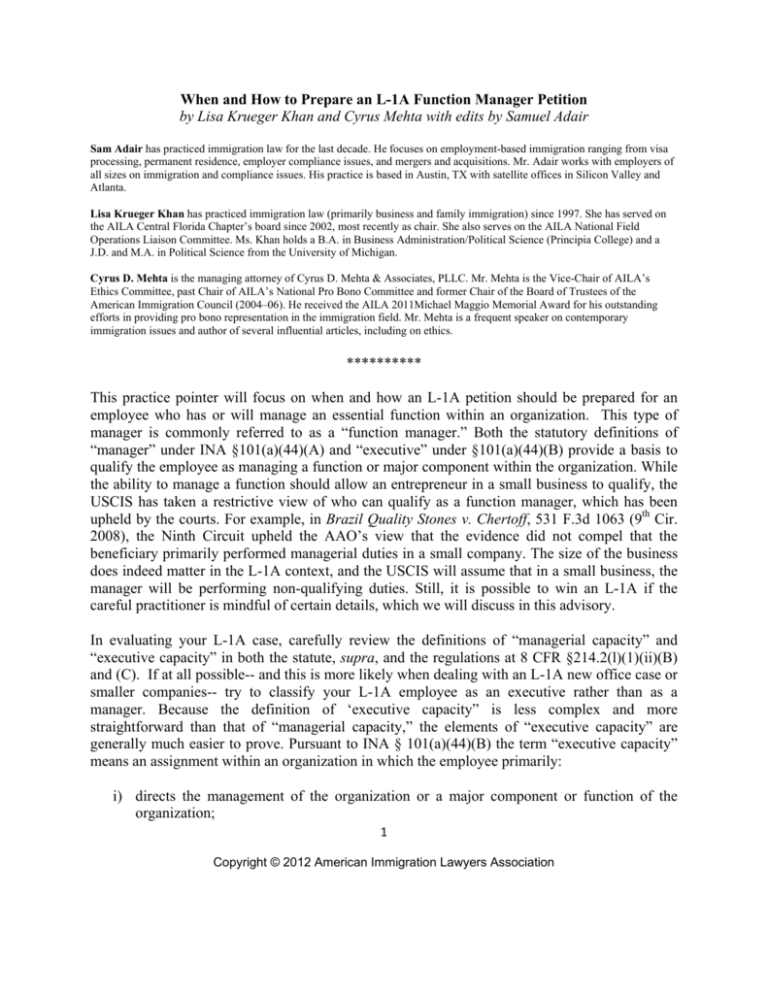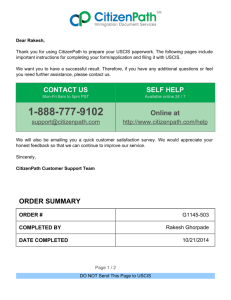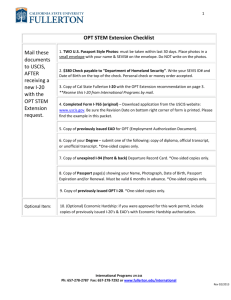L-1A Function Manager Petition Guide
advertisement

When and How to Prepare an L-1A Function Manager Petition by Lisa Krueger Khan and Cyrus Mehta with edits by Samuel Adair Sam Adair has practiced immigration law for the last decade. He focuses on employment-based immigration ranging from visa processing, permanent residence, employer compliance issues, and mergers and acquisitions. Mr. Adair works with employers of all sizes on immigration and compliance issues. His practice is based in Austin, TX with satellite offices in Silicon Valley and Atlanta. Lisa Krueger Khan has practiced immigration law (primarily business and family immigration) since 1997. She has served on the AILA Central Florida Chapter’s board since 2002, most recently as chair. She also serves on the AILA National Field Operations Liaison Committee. Ms. Khan holds a B.A. in Business Administration/Political Science (Principia College) and a J.D. and M.A. in Political Science from the University of Michigan. Cyrus D. Mehta is the managing attorney of Cyrus D. Mehta & Associates, PLLC. Mr. Mehta is the Vice-Chair of AILA’s Ethics Committee, past Chair of AILA’s National Pro Bono Committee and former Chair of the Board of Trustees of the American Immigration Council (2004–06). He received the AILA 2011Michael Maggio Memorial Award for his outstanding efforts in providing pro bono representation in the immigration field. Mr. Mehta is a frequent speaker on contemporary immigration issues and author of several influential articles, including on ethics. ********** This practice pointer will focus on when and how an L-1A petition should be prepared for an employee who has or will manage an essential function within an organization. This type of manager is commonly referred to as a “function manager.” Both the statutory definitions of “manager” under INA §101(a)(44)(A) and “executive” under §101(a)(44)(B) provide a basis to qualify the employee as managing a function or major component within the organization. While the ability to manage a function should allow an entrepreneur in a small business to qualify, the USCIS has taken a restrictive view of who can qualify as a function manager, which has been upheld by the courts. For example, in Brazil Quality Stones v. Chertoff, 531 F.3d 1063 (9th Cir. 2008), the Ninth Circuit upheld the AAO’s view that the evidence did not compel that the beneficiary primarily performed managerial duties in a small company. The size of the business does indeed matter in the L-1A context, and the USCIS will assume that in a small business, the manager will be performing non-qualifying duties. Still, it is possible to win an L-1A if the careful practitioner is mindful of certain details, which we will discuss in this advisory. In evaluating your L-1A case, carefully review the definitions of “managerial capacity” and “executive capacity” in both the statute, supra, and the regulations at 8 CFR §214.2(l)(1)(ii)(B) and (C). If at all possible-- and this is more likely when dealing with an L-1A new office case or smaller companies-- try to classify your L-1A employee as an executive rather than as a manager. Because the definition of ‘executive capacity” is less complex and more straightforward than that of “managerial capacity,” the elements of “executive capacity” are generally much easier to prove. Pursuant to INA § 101(a)(44)(B) the term “executive capacity” means an assignment within an organization in which the employee primarily: i) directs the management of the organization or a major component or function of the organization; 1 Copyright © 2012 American Immigration Lawyers Association ii) establishes the goals and policies of the organization, component or function; iii) exercises wide latitude in discretionary decision-making; and iv) receives only general supervision or direction from higher level executives, the board of directors, or stock holders of the organization. Once you determine the appropriate classification, be consistent in your documentation. Do not refer to the L-1A beneficiary as an “executive/ manager.” Choose your definition and then prove in your documentation each element of the relative definition. Immigration will often incorrectly use the terms “executive” and “manager” interchangeably and/or commingle the definitions of both terms. For example, if you receive an RFE asking for proof that your executive “controls the work of other supervisory, professional or managerial employees,” do not hesitate to respectfully point out to the requesting officer that the definitions of “executive capacity” and “managerial capacity” are statutorily distinct and underscore that the beneficiary is an “executive” and not a manager. There is no need to prove that your executive is a manager or vice versa. If it is not possible to classify the L-1A beneficiary as an executive, carefully review the four criteria in the definition of managerial capacity. To qualify as an L-1A manager, all four components of the definition must be met. Pursuant to INA § 101(a)(44)(A), the position must be one in which the employee primarily: i) Manages the organization, or a department, subdivision, function, or component of the organization; ii) Supervises and controls the work of other supervisory, professional, or managerial employees, or manages an essential function within the organization, or a department or subdivision of the organization; iii) Has the authority to hire and fire or recommend those as well as other personnel actions (such as promotion and leave authorization) if another employee or other employees are directly supervised; if no other employee is directly supervised, functions at a senior level within the organizational hierarchy or with respect to the function managed; and iv) Exercises direction over the day-to-day operations of the activity or function for which the employee has authority. A first-line supervisor is not considered to be acting in a managerial capacity merely by virtue of the supervisor’s supervisory duties unless the employees supervised are professional. Note first the word “primarily” in the definition. It will not be enough that the manager is partially engaged in the tasks above; he/she must primarily be engaged in such activity. As a general guideline, “primarily’ usually means more than 50% of the time. To this end, be sure to attach a percentage of time to each of the managerial job duties in which the beneficiary will engage. 2 Copyright © 2012 American Immigration Lawyers Association Per the first prong of the definition, articulate what the L-1A beneficiary manages. A detailed employer letter should state if he/she manages the entire organization and if not, specify which department, subdivision, function or component within the organization he/she manages. A description of what the department or function does and how it is critical to overall operations is important. An entity organizational chart or diagram is especially helpful. The second prong of the definition is where “function manager” comes into play. . If the L-1A beneficiary will supervise and control the work of other employees, such subordinate employees must also be supervisory or managerial employees in their own right (tricky to show in the smaller company context) or they must be professionals. (A professional is an individual who is a member of the professions, such as architects, engineers, lawyers, physicians, surgeons, and teachers in elementary or secondary schools, colleges, academies, or seminaries). However, it may be possible to define a professional in the same way that one would do under an H-1B petition. If the employees supervised by the manager have bachelor’ degrees or equivalents, and their positions require such specialized degrees, then you can argue that the manager is supervising professionals. When a manager supervises professionals, he or she can be a first-line supervisor rather than managing other subordinate managers and supervisors. If your L-1A manager is not supervising and controlling other supervisors, managers or professionals (and you’ve ruled out your L-1A qualifying under “executive capacity,”) then you’ve got yourself a function manager case! How does one prove that an employee has managed or will manage an essential function within an organization? Details, details, details! For a successful function manager petition, it is very important to include a detailed employer letter from an authorized representative of the US and/or foreign entity which addresses: the managerial decisions the beneficiary is expected to make for the US entity a description of the typical managerial duties and the percentage of time to be spent on each duty how the beneficiary will manage a function or department or subdivision within the organization if the beneficiary will manage a function, what makes the function “‘essential” (quantifying how essential a function is with sales or productivity figures, for example, is a great way to show that it is essential) In addition to a detailed employer letter(s), additional documents that may demonstrate that one has managed an essential function could include memos, emails, contracts, letters of intent, calendar/diary entries, and other business documentation that actually demonstrate the specific managerial tasks in which the beneficiary has engaged or managerial decisions the L-1A beneficiary has made. The third prong of the managerial definition relates to hiring, firing, and personnel-related authority over directly supervised employees. Your function manager may not supervise and 3 Copyright © 2012 American Immigration Lawyers Association control the work of other supervisory, professional, or managerial employees, but he/she may supervise and control non-supervisory, non-professional, non-managerial employees. While that won’t work to prove the second prong of the definition of “managerial capacity,” it counts under the third prong of the definition. This can also be addressed with specificity in an employer statement, a staffing chart or company organization chart or employee list detailing the names, job titles, and job duties of those supervised. It is important to underscore that subordinate employees are directly supervised by the manager, and most importantly, relieve the manager from the day to day non-qualifying duties. Personnel records of the subordinate employees, such as annual reviews, pay raise considerations, employee reprimands, etc. that show the name of the L-1A manager having made or recommended personnel actions are very useful. If no other employees are directly supervised, then you must demonstrate instead that the function manager “functions at a senior level within the organizational hierarchy or with respect to the function managed.” It may be that the function manager does not directly supervise employees, but “indirectly” supervises subordinate staff. Or, a function manager may not directly supervise employees, but may be charged with supervising independent contractors or subcontractors. Again, a detailed organization/staffing chart is key to showing that the function manager exercises authority at a senior level and that there are other personnel who will actually execute the more mundane duties of the function. Don’t forget to include independent contractors or subcontractors here as well in showing that the function manager holds a senior position vis-à-vis others who carry out the activities of the managed function. With respect to independent contractors, it may be helpful to demonstrate who the manager interacts with at the independent contractor firms. For example, if the petitioner has retained a marketing firm to promote its products or services, you should also highlight whether this marketing firm is prestigious, and that the people working in the firm are also executives, managers or professionals. Finally, a solid L-1A function manager petition will also demonstrate that the beneficiary exercises discretion over the day-to-day operations, but at the same time takes pains to demonstrate how subordinates will relieve the manager of the non-qualifying operational activities. The employer statement should also articulate how the beneficiary will make decisions on daily operations of the activity or function under his or her authority and to whom, if anyone, he/she must report to or consult with prior to making such decisions. Having the employer affirm in writing that a high degree of autonomy or discretionary decision-making is accorded to the function manager will certainly assist in showing that one functions at a senior level. Additional documentation that can help to show “managerial capacity” includes the beneficiary’s training, pay, or other personnel records which demonstrate that the position was/is managerial in nature. A high salary and/or company benefits such as a company car, expense account, or performance-based bonus, are indicative of a higher-level, managerial position and these points should be underscored if applicable. 4 Copyright © 2012 American Immigration Lawyers Association Moreover, despite the potentially unfavorable view that the USCIS may adopt towards a small business, cite decisions to demonstrate that managers in small businesses in the past have been able to obtain L-1A classification. Indeed, the former Immigration and Naturalization Service and its Administrative Appeals Unit (AAU), the predecessor to the AAO, have previously issued decisions in line with such a more appropriate standard. In 1994, the AAU approved an L-1 petition for the general manager of the North American branch of a Japanese karaoke sound equipment company, who would be in charge of North American operations but would only oversee three employees. Unpublished decision relating to LIN 94 049 50267, summarized in 71 No. 26 Interpreter Releases 897. In 1992, a petition was approved for the president of a company in the business of buying and selling aircraft equipment, who supervised only one other employee. See Matter of X, 10 Imm. Rptr. B2-13 (AAU Apr. 13, 1992), cited in GORDON, MAILMAN, YALE-Loehr § 24.05[2] at 24–28 & n.23. In 1996, the AAU approved an L-1A petition for the sole employee of a scrap-metal company, who would act through subcontractors to obtain scrap metal for export, and develop real estate. See Matter of X, 16 Imm. Rptr. B2-84 (AAU Feb. 29, 1996), cited in GORDON, ET AL., supra, § 24.05[2] at 24–28 & n.22. Moreover, any any concern that the L-1A visa would be abused by investors and entrepreneurs who own small businesses overseas and then start up a small U.S. firm in order to sponsor themselves for the L-1A visa, is alleviated by the requirement that the foreign entity must continue doing business during the foreign national’s stay in the United States. See 8 C.F.R. § 214.2(l)(1)(ii)(G).1 Finally, make the argument that the L-1A petition is being filed pursuant to the August 2, 2011 announcement of Department of Homeland Security (DHS) Secretary Napolitano United States Citizenship and Immigrant Services (USCIS) Director Mayorkas that foreign entrepreneurs could take advantage of the existing non-immigrant and immigrant visa system to gain status and permanent residency. According to the press release from the Department of Homeland Security dated August 2, 2011,2 administrative tweaks within the existing legal framework would “fuel the nation’s economy and stimulate investment by attracting foreign entrepreneurial talent of exceptional ability.” In the H-1B Question and Answers accompanying the August 2, 2011 announcement,3 1 If the beneficiary is a major stockholder or owner, “the petition must be accompanied by evidence that the beneficiary's services are to be used for a temporary period and evidence that the beneficiary will be transferred to an assignment abroad upon the completion of the temporary services in the United States.” 8 C.F.R. § 214(l)(3)(vii). 2 This press release, Secretary Napolitano Announces Initiatives to Promote Startup Enterprises and Spur Job Creation, is available at http://www.dhs.gov/ynews/releases/20110802-napolitanostartup-job-creation-initiatives.shtm. 3 See Questions & Answers: USCIS Issues Guidance Memorandum on Establishing the “Employer–Employee Relationship” in H-1B Petitions, published on January 13, 2010, revised 5 Copyright © 2012 American Immigration Lawyers Association the USCIS appears to still insist about the need to demonstrate an employer-employee relationship, but has conceded that this can nevertheless be demonstrated even when the owner of the company is being sponsored on an H-1B visa. This may be established by creating a separate board of directors, which has the ability to hire, fire, pay, supervise and otherwise control the Beneficiary. While there was no similar guidance for L-1A, argue that the employeremployee relationship, which has infected H-1B petitions, was never an issue for the L-1A, and it must be interpreted consistent with the new DHS initiative to encourage entrepreneurs. As noted in the Entrepreneurs in Residence Initiative press conference on October 11, 2011, “if you look at the recent economic research it shows that small high growth firms account for a disproportionate number of the net jobs created in the United States and therefore Startup America is about celebrating, inspiring, and accelerating high growth entrepreneurship across the country.”4 USCIS Director Alejandro Mayorkas has pledged support for entrepreneurs stating that “[c]urrent immigration laws support foreign talent who will invest their capital, create new jobs for American workers, and dedicate their exceptional talent to the growth of our nation’s economy . . . USCIS is dedicated to ensuring that the potential of our immigration laws is fully realized . . . .” 5 At the October 11, 2011 press conference for the “Entrepreneurs in Residence” Initiative, Director Mayorkas emphasized that the purpose of the initiative was to spur development of policies and protocols that “we are capturing the full power of the laws that currently exist to attract talent, to spur entrepreneurial growth, to maximize innovation all for the benefit of our economy and the American worker.”6 The USCIS has followed through with this initiative for Entrepreneurs in Residence, hosting the first summit on February 22, 2012, during which Director Mayorkas remarked “[t]oday USCIS gained invaluable insights from prominent on August 2, 2011 and further revised on March 12, 2012, available at http://www.uscis.gov/portal/site/uscis/menuitem.5af9bb95919f35e66f614176543f6d1a/?vgnexto id=3d015869c9326210VgnVCM100000082ca60aRCRD&vgnextchannel=6abe6d26d17df110Vg nVCM1000004718190aRCRD. 4 USCIS, “Entrepreneurs in Residence” Initiative, Press Conference, October 11, 2011, remarks of Tom Kalil, White House Office of Science and Technology Policy Deputy Director for Policy, transcript available at http://www.uscis.gov/USCIS/News/2011/October%202011/transcript_eir_11Oct11.pdf. 5 USCIS press release, August 2, 2011, USCIS Office of Public Engagement: Initiatives to Promote Startup Enterprises, supra. 6 USCIS, “Entrepreneurs in Residence” Initiative, Press Conference, October 11, 2011, supra, remarks of USCIS Director Alejandro Mayorkas. 6 Copyright © 2012 American Immigration Lawyers Association entrepreneurs and industry leaders on immigration issues critical to our nation’s economic prosperity.”7 7 “USCIS Hosts Entrepreneurs in Residence Information Summit” available at http://www.uscis.gov/portal/site/uscis/menuitem.5af9bb95919f35e66f614176543f6d1a/?vgnextoid=b143f754f66a53 10VgnVCM100000082ca60aRCRD&vgnextchannel=68439c7755cb9010VgnVCM10000045f3d6a1RCRD 7 Copyright © 2012 American Immigration Lawyers Association Intra-Company Transfer Visas: L-1s for Experienced Practitioners May 1, 2012 Additional Resources Matter of [name not provided], WAC-07-277-53214 (AAO, July 22, 2008) (Commonly Referred to as GST); 2008 WL 5063578; http://www.uscis.gov/err/D7%20-%20Intracompany%20Transferees%20(L-1A%20and%20L1B)/Decisions_Issued_in_2008/Jul222008_04D7101.pdf. AILA Memo to USCIS regarding Specialized Knowledge http://www.aila.org/content/default.aspx?docid=38301 [AILA Doc. No. 12012560] Brazil Quality Stones v. Chertoff http://www.aila.org/content/default.aspx?docid=29466 [AILA Doc. No. 09070862.] DOS Visa Policy Update: Guidance on L Visas and Specialized Knowledge http://www.aila.org/content/default.aspx?docid=34248 [AILA Doc. No. 11012433] INS Memo on L-1B Specialized Knowledge Multinationals (“The Puleo memo”) [AILA Doc. No. 01052171] INS Memo on Standards for Specialized Knowledge (“The Ohata memo”) [AILA Doc. No. 03020548] Visa Policy Update: Guidance on L Visas and Specialized Knowledge [AILA Doc. No. 11012433] USCIS Draft RFE Template for L-1 Manager or Executive [AILA Doc. No. 12010573] 2012 AILA Teleconference/Web Conference © 2012 American Immigration Lawyers Association






